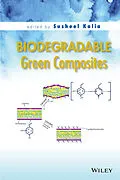This book comprehensively addresses surface modification of natural fibers to make them more effective, cost-efficient, and environmentally friendly. Topics include the elucidation of important aspects surrounding chemical and green approaches for the surface modification of natural fibers, the use of recycled waste, properties of biodegradable polyesters, methods such as electrospinning, and applications of hybrid composite materials.
Autorentext
Susheel Kalia is Researcher in Department of Civil, Chemical, Environmental and Materials Engineering at University of Bologna, Italy. Kalia's research is in the field of biocomposites, nanocomposites, conducting polymers, cellulose nanofibers, inorganic nanoparticles, hybrid materials, hydrogels and cryogenics. The author of many international papers, articles and chapters, he has published many review articles on polymeric composites based on natural fibers. Kalia's editorial activities include work as a reviewer and memberships of editorial boards for various international journals. He is also a member of a number of professional organizations, including the Asian Polymer Association, Indian Cryogenics Council, the Society for Polymer Science, Indian Society of Analytical Scientists, and the International Association of Advanced Materials.
Inhalt
Contributors xii
Preface xiv
1 Biodegradable Green Composites 1
Sreerag Gopi, Anitha Pius, and Sabu Thomas
1.1 Introduction 2
1.2 Biodegradable Polymers 2
1.2.1 Starch 2
1.2.2 Cellulose 4
1.2.3 Chitin and Chitosan 4
1.2.4 Proteins 5
1.3 Nanofillers for Composites 5
1.3.1 CelluloseBased Nanofillers 5
1.3.2 Carbon Nanotube 7
1.3.3 Clay 7
1.3.4 Functional Fillers 7
1.4 Nanocomposites from Renewable Resources 8
1.4.1 Cellulose Nanocomposites 9
1.4.2 CNT Nanocomposites 9
1.4.3 Clay Nanocomposites 10
1.4.4 Functional Nanocomposites 10
1.5 Processing of Green Composites 10
1.6 Applications 11
1.6.1 Packaging 11
1.6.2 Electronics, Sensor, and Energy Applications 11
1.6.3 Medicinal Applications 12
1.7 Conclusion 12
References 12
2 Surface Modification of Natural Fibers Using Plasma Treatment 18
Danmei Sun
2.1 Introduction 19
2.1.1 Natural Fiber Materials and their Properties 19
2.1.2 Conventional Modification Methods and Drawbacks 19
2.1.3 Plasma Environment and the Advantages of Plasma Surface Modification 20
2.2 Mechanisms of Plasma Treatment and Types of Plasma Machines 21
2.2.1 Principle of Plasma Surface Modification 21
2.2.2 Interactive Mechanisms between Plasma and Substrates 22
2.2.3 Types of Plasma Treatment Systems 24
2.3 Effects and Applications of Plasma Treatment 27
2.3.1 Surface Morphology and Chemical Composition Change 27
2.3.2 Improved Hydrophilicity and Efficiency in Aqueous Processes 28
2.3.3 Improved Hydrophobicity 31
2.3.4 Mechanical Properties Affected by Plasma Treatment 33
2.3.5 Medical Applications of Plasma Treatment 34
2.3.6 PlasmaModified Fibers in Polymer Composites 34
2.3.7 Other Areas of Applications 35
2.4 Conclusions and Industrial Implications 35
References 35
3 Reinforcing Potential of Enzymatically Modified Natural Fibers 40
Levent Onal and Yekta Karaduman
3.1 Introduction 41
3.2 Enzymes 42
3.2.1 A Brief History 42
3.2.2 Classification and Nomenclature 43
3.2.3 Enzyme Structure 43
3.2.4 Enzymatic Catalysis 44
3.3 Natural Fibers as Enzyme Substrates 45
3.3.1 Physical Properties of Lignocellulosic Fibers 46
3.3.2 Chemical Properties and Composition of Lignocellulosic Fibers 47
3.3.2.1 Cellulose 47
3.3.2.2 Hemicellulose 49
3.3.2.3 Lignin 49
3.3.2.4 Pectin 50
3.3.2.5 Other Aromatic Compounds 51
3.3.2.6 Fats, Waxes, and Lipids 51
3.4 Types of Enzymes Used in Natural Fiber Modification 51
3.4.1 Cellulases 51
3.4.2 Xylanases 52
3.4.3 Pectinases 53
3.4.4 Laccases 53
3.5 Effect of Enzymatic Treatment on the Structure and Properties of Natural Fibers 54
3.6 Polymer Composites Reinforced with Enzymatically Modified Natural Fibers 62
3.7 EnzymeAssisted Biografting Methods 69
3.8 Conclusions 73
References 74
4 Recent Developments in Surface Modification of Natural Fibers for their use in Biocomposites 80
Jaspreet Kaur Bhatia, Balbir Singh Kaith, and Susheel Kalia
4.1 Introduction 81
4.2 Biocomposites 82
4.2.1 Classification: Biomass Derived and PetroleumDerived Matrix 83
4.2.2 Advantage over Traditional Composites 86
4.3 Natural Fiber: Structure and Composition 86
4.4 Surface Modification of Natural Fibers 89
4.4.1 Silylation, Esterification, and other Surface Chemical Modifications 89
4.4.2 Noncovalent Surface Chemical Modifications 93
4.4.3 Cationizati...
